Mandatory masks by month’s end, if not sooner, says Monroe County’s health administrator
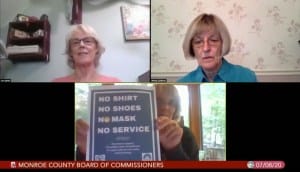
On Wednesday, health administrator Penny Caudill said the next COVID-19 health order from county health officer Thomas Sharp would have some kind of requirement for wearing a mask in public.

The next order will be issued by the end of the month if not before, Caudill said.
The news from Caudill came during her update to county commissioners during their regular weekly meeting on Wednesday.
A new health order, without a mandatory mask wearing requirement, was issued starting July 4. That order will stay in effect, “until repealed or replaced.”
About the next health directive that could replace the July 4 order, Caudill said on Wednesday, “Final determinations have not been made,” but added, “We do expect that it will include some kind of face covering requirement while in public.”
A push for a requirement on mask wearing to help slow the spread of the COVID-19 virus, has come from different quarters before and since the July 4 order was announced, without a mask wearing requirement.
What the July 4 order does require is that by July 8, business had to have posted a sign at least 8 x 10 inches big at their entrances that “requests patrons wear a face covering while on the premises, in order to protect employees, other customers and those with whom they are in contact.”
Under the July 4 order, the posting of the sign with a request to wear masks is mandatory, but the wearing of masks itself is not. What has led to some confusion is the promotion by community leaders of the idea that businesses can also require their customers to wear masks.
For areas businesses, county commissioners and the public health department have produced window clings that say, “No Shirt, No Shoes, No Mask, No Service.” They’re available at the north entrance of courthouse building, off 6th Street, on Tuesdays and Thursdays, from 10 a.m to -noon and 1-5 p.m. The clings are also being distributed by the Greater Bloomington Chamber of Commerce and Downtown Bloomington, Inc.
During last Thursday’s press conference, Caudill foreshadowed the possibility of an eventual mask wearing requirement by saying the health officer has the authority to impose a mandate for residents to wear facial coverings when in public. The possibility of issuing a local mandate “has always been on the table,” she said at the time.
At the same press conference, Bloomington’s mayor, John Hamilton, said that Bloomington’s city council could enact an ordinance for Bloomington. But the mayor indicated a preference for working on a unified approach with the county government. Hamilton said that it would be preferable to have a national order, given that COVID-19 is a national pandemic.
Caudill said last week the preference in Monroe County has been to “use the approach of everybody owning their own responsibility.” She would rather get voluntary compliance, instead of mandating it, adding that some people will not wear a mask, no matter what.
Caudill also cautioned last week that a mask mandate would require additional personnel and labor for enforcement—the existing health orders had already added to the work load of the department, she said.
On Wednesday, Caudill said the health department is developing a plan of to handle the additional influx of complaints and the corresponding enforcement that will be needed, when the mask wearing requirement goes into effect.
Another detail to be worked out, Caudill said on Wednesday, is how reasonable expectations or accommodations for non-wearing of masks will be defined.
Caudill said the next health order from health officer Sharp would come by the end of the month if not before then.
The next meeting of seven-member bipartisan board of public health, which appoints the health officer, is scheduled for July 21. The board could decide to call a special meeting for earlier than that, which is possible under Indiana’s Open Door Law with 48-hour advanced notice.
Work on the next health order involves conversations with county and city electeds, Indiana University officials, hospital leaders and review of other information and data, Caudill told county commissioners on Wednesday.
Some of the other data to be considered will likely include the increase in the number of confirmed positive cases in Monroe County, which is somewhat outpacing the increase in the number of tests. That’s especially true among residents age 20 to 29.
Caudill mentioned the increase in that age group her remarks to commissioners on Wednesday. The potential for greater community spread of COVID-19 has to be accepted as people venture out more after the strict stay-at-home orders lifted and businesses have started re-opening, Caudill said.
By the numbers, since June 17 in Monroe County, people age 20–29 account for around 21.8 percent of COVID-19 tests, but about 35.5 percent of confirmed positive cases.
That’s 13.5 percentage points more confirmed positives from that age group than would be expected, if the positive test rate were uniform across all age groups. Put another way, it’s more than half again as many as would be expected.
Asked by The Square Beacon about any working theories for the increase in the 20–29 age bracket, Caudill said, “It seems reasonable to think that social gatherings/events with no distancing and little mask wearing is a major factor.”
Caudill said she’s also curious about why more people in that age group are getting tested. Questions she’s wondering about include: Are they symptomatic? Did a contact refer them? Did they go somewhere they thought could pose a risk? Could it be that the initial push for people over 60 to get tested has passed, and we’ve just moved on? Is the upcoming start of school motivating people to get themselves tested?
The total number of deaths due to COVID-19 in Monroe County now stands at 28. The last one was recorded on June 21, which was 17 days ago.
The severity of cases appears to be going down. Overall hospital admissions in Monroe County in June numbered 8, compared to 23 in April, despite similar positive test numbers. Those numbers: In April there were 92 confirmed cases; in June, there were 90 confirmed cases.
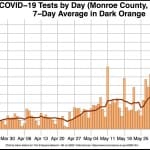
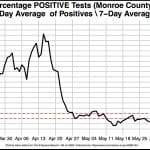
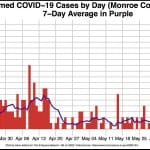
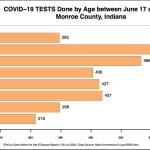
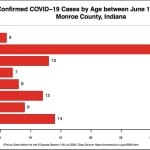




Comments ()